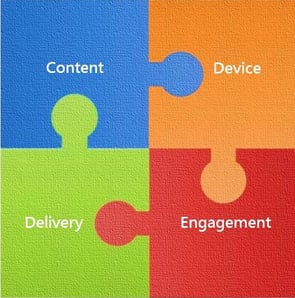With the increase in adoption of smartphones and penetration of mobile broadband, organisations are now focusing more on mobile learning (M-learning) than ever before. As L&D teams are prioritising learning on the go, there are several factors that you need to consider to ensure that the implementation and adoption of mobile learning is successful in your organisation.
We, at Teamie, have built a framework (please refer to the figure below) to help you plan, implement and measure the effectiveness of mobile learning for your learners. This framework takes into consideration four aspects - Device, Content, Delivery & Engagement.

Figure: Framework for Effective Mobile Learning
Let us look at some of the best practices associated with these four aspects.
Device
As there are variety of mobile devices in the market that run on different versions of operating systems and have varying screen sizes, hence it is important for the training team to decide on which devices do they primarily want to target and if the content is designed for those devices in a suitable manner.
Content
From choosing the language (Flash or HTML5) to deciding on the standards (SCORM), there are quite a number of factors that should be kept in mind while developing the content for mobile learning. Interactive and bite-sized videos are a good way to keep the learners engaged however size of the content should also be kept into consideration for geographies where mobile broadband is still evolving.
Delivery
Native apps for Android and iOS mobile devices are a must-have these days, however having an offline option i.e. to access the content even when your learners are not connected to internet, is a plus. A Mobile Learning Management System (M-LMS) that can track the learning and engagement status of the learners and show them the necessary insights within the mobile app itself, is highly recommended.
Engagement
Leveraging gamification is a good strategy to keep your learners engaged and make them come back to the learning app for more. Social or collaborative learning is also a good way to promote peer learning as it gives avenues to the learner through which they can share their experiences with the group and learn together!
Want to learn more about these best practices?
Download the report that covers in detail how you can take into consideration Device, Content, Delivery and Engagement aspects to make mobile learning effective for your teams.



Leave a Reply